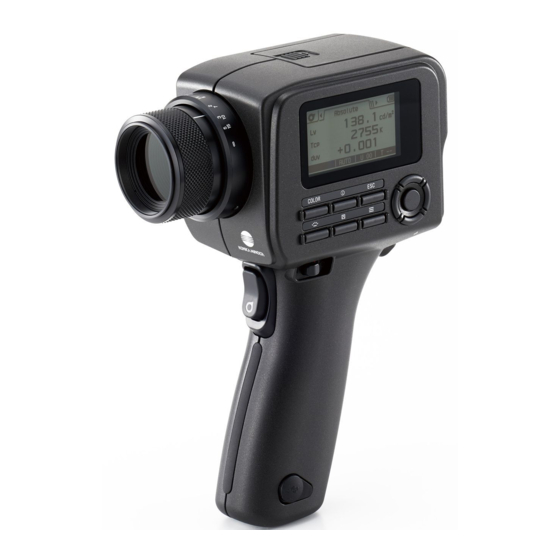
Summarization of Contents
Safety Precautions and Warnings
Safety Precautions
Details essential safety instructions to prevent injury or damage.
CAUTION
Highlights important warnings and precautions for safe operation.
Introduction to the Chroma/Luminance Meter
Product Packing Materials
Guidance on keeping and using packing materials for safe transport.
Operating Environment Recommendations
Specifies suitable conditions for instrument installation and use.
Instrument Handling and Maintenance
Backup Battery Information
Details on the internal backup battery's function and replacement.
Objective and Close-up Lens Care
Instructions for proper handling and cleaning of lenses.
Recommended Battery Types
Guidance on selecting the appropriate batteries for optimal performance.
Storage, Cleaning, and Transportation
Instrument Storage Guidelines
Recommendations for storing the instrument to maintain performance and prevent damage.
Cleaning Procedures
Instructions for cleaning the instrument and its objective lens.
Transportation Procedures
Guidelines for safely transporting the instrument.
Maintenance and Inspection
Importance of periodic inspection for maintaining measurement accuracy.
Disposal Method
Information on the correct disposal or recycling of the instrument and accessories.
Accessories
Standard Accessories Included
Lists and describes the standard accessories provided with the instrument.
Optional Accessories Available
Lists and describes optional accessories for enhanced functionality.
Instrument Parts and Functions
Part Names Identification
Identifies and labels the physical parts of the instrument.
Major Part Functions Explained
Describes the primary functions of each instrument component.
Key Panel Operation
Key Panel Layout
Illustrates the layout of the instrument's key panel.
Major Key Functions
Explains the primary functions assigned to each key on the panel.
Viewfinder Information
Viewfinder Display Details
Describes what is shown on the viewfinder display.
Visibility Adjustment
Guides on adjusting viewfinder visibility for clear observation.
LCD Screen Interface
LCD Screen Layouts
Shows the structure and elements of the measurement and setting screens.
Instrument Menu Structure
Outlines the hierarchical structure of the instrument's menu system.
Instrument Messages
First Startup Messages
Messages displayed during the initial setup of the instrument.
Daily Operation Messages
Common messages encountered during routine use of the instrument.
Preparation for Use
Installing Batteries
Step-by-step guide for correctly installing batteries in the instrument.
Battery Level Indicator
Explains how to interpret the battery level indicator on the LCD screen.
Wrist Strap Usage
Attaching the Wrist Strap
Instructions for securing the wrist strap to the instrument.
Safe Carrying Practices
Guidelines for safely holding and carrying the instrument with the strap.
Settings
Integration Time Selection
How to select the appropriate integration time for measurements.
Synchronized Measurement Mode
Setting up measurement synchronization with flashing light sources.
Max/Min Value Selection
Choosing to display maximum, minimum, or latest measurement values.
Color Space Configuration
Setting up selectable color spaces for measurement display.
Chromaticity Decimal Places
Adjusting the number of decimal places for chromaticity display.
Color Correction Factor (CCF)
Inputting color correction factors for accurate measurements.
Close-up Lens Type Setting
Setting the type of close-up lens attached for accurate measurements.
Measuring Button Function
Configuring the behavior of the measurement button (Standard/Toggle).
Measurement Result Saving
Setting automatic or manual saving of measurement results.
Display Brightness Adjustment
Adjusting the brightness of the instrument's LCD screen.
Backlight Control
Turning the external LCD screen backlight ON or OFF.
Auto Power Off Setting
Configuring the auto power-off function to save battery.
Calibration Alert Display
Enabling or disabling periodic calibration reminder messages.
Luminance Unit Selection
Setting the preferred unit for displaying luminance values.
Initializing the Settings
Resetting instrument settings to factory defaults.
Setting the Internal Clock
Adjusting the instrument's internal clock for date and time.
Display Language Selection
Choosing the language for the instrument's LCD display.
Checking Instrument Information
Viewing version and other details about the instrument.
Measurement Preparation
Calibration Procedures
Steps for calibrating the instrument using calibration channels.
User Calibration Methods
Explains how to perform user-specific calibration for accuracy.
Performing User Calibration
Detailed steps for measuring and registering calibration data.
Calibration Value Input Rules
Specifies the valid ranges for inputting calibration values.
Setting/Changing the Target
Target by Measurement
Procedure to set a target by measuring and registering it.
Target by Stored Data
Procedure to set a target from previously stored measurement data.
Target by Entering Values
Procedure to manually enter target values.
Measurement Operations
Measuring Circle and Distance
Information on measuring distance and area with and without close-up lenses.
Visibility Adjustment
Guides on adjusting viewfinder visibility for optimal observation.
Focus Adjustment
Instructions for adjusting the focus of the objective lens for clear imaging.
Performing Measurement
Step-by-step guide on how to take a measurement using the instrument.
Displaying Measurement Results
How to switch between absolute, difference, and ratio displays.
Communication with a PC
Connecting to a PC via USB
Instructions for establishing a USB connection between the instrument and a PC.
Explanation and Information
Light-Receiving Element (Sensor)
Technical details about the instrument's sensor and spectral responsivity.
Color Space Definitions
Explains the Lv Tcp duv color space and related parameters.
Dominant Wavelength and Excitation Purity
Defines dominant wavelength and excitation purity concepts.
Object Color Measurement
Guide to performing simplified object color measurements using user calibration.

















Need help?
Do you have a question about the LS-160 and is the answer not in the manual?
Questions and answers